Women’s History Month: Candace Agonafir
Interviewing Candance Agonafir
Candace Agonafir is a PhD Candidate at the City College of New York (CCNY) in Civil Engineering. She received her MS at New York University (NYU) and BS at St. John’s University. She is originally from the Midwest. Currently, she is a NOAA CESSRST fellow conducting research at CCNY.
Using Twitter to share the news about the NYC Street Flood Monitor by Candace Agonafir
In our first paper, titled “Understanding New York City street flooding through 311 complaints”, published in the Journal of Hydrology, we find that the negative binomial generalized regression model performed with lower variability when there was more crowdsourced information. In our second paper, titled “A Machine Learning Approach to Evaluate the Spatial Variability of New York City Street Flooding”, currently under peer review at the journal of Computers, Environment, and Urban Systems, we also see that more crowdsourced reports increased our Random Forest regression model performance. Due to these studies, this Twitter account was inspired. The aim is for residents or visitors of NYC to tag @nyc_flood. I will import the geolocations into R and then display the locations on Google Maps. In this way, as a community, we will have a platform, highlighting urban flooding in real-time. We lost 13 people during the tropical event caused by Hurricane Ida last fall. By showing localized flooding in real-time, it will allow people to assess their risks and take preventive measures.
What is you background? How did you get to where you can today in your academic journey?
I grew up middle class until my mother left my father before my senior year in high school. From then on, I was working for her and myself. From an early age I was academically driven. I was chosen out of 100 students in my grade for the accelerated, gifted program. I went on to be accepted into an intensive middle school and private high school. Eventually, I transferred to a public high school. This high school was known to have a competitive athletic division. This particular public high school was also strong, academically. The teachers and schools trained me well, and I was given skills that lasted a lifetime.
What obstacles have you faced in your journey as a Women in the Earth System Sciences? How did you overcome them?
In the workforce, I tend to be paid less. For women, I believe, when you have goals and work for them, it could be looked at as “showing off”, for some reason. Innocently, you want the best for you and your family, and unfortunately, it is offensive to some people. Life is all about perception. Even good people can be hurtful if they see you in the wrong light. If you are able to overcome misconceptions, it is by working harder than your peers work. In life, you don’t necessarily get what is fair.
What does Women’s History Month mean to you?
It is nice. It is good to celebrate.
What has been your biggest motivation?
My family motivates me. My grandfather and my aunt have accomplished so much. My mother believes it is due to their work ethic, and she has fostered that into my subconscious at an early age.
What advice would you give young women who are interested in the Earth Systems Sciences?
Work harder than your peers do. Keep moving. Keep pivoting. Try to be merciful in your heart. Don’t think too much about those who are unfair to you. Try to move past it. Be humble, but if you do something good, don’t hide it. Don’t cover for other people’s wrongs.

